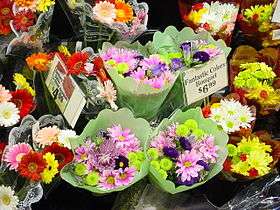Additives for cut flowers

Additives for cut flowers are substances added to water, intended to extend the viability of cut flowers. Once flowers are removed from the plant they continue to grow slowly, but have a diminished capability of receiving the nutrients that are vital for their survival.
There are different techniques of ensuring that fresh cut flowers remain alive for the longest amount of time.
Sterilization
According to James C. Schmidt, a horticulturist at the University of Illinois, originally putting cut flowers in a sterilized vase is important to extending the life of the flowers. Vases can be cleaned using a household dish detergent or a combination of water and bleach. Using these disinfectants ensures that there will be less bacteria growing within the vase that could potentially cause the plant to wilt and die at a faster rate. Schmidt also claims that cutting the flowers diagonally with a sharp knife under running water ensures that they can immediately take up fresh and clean water. Re-cutting the stems periodically will ensure that there is a fresh surface from which the stems can take up water. This will allow the flowers to last even longer.
Additives
According to the Brooklyn Botanical Garden, different additives can be used to prolong the lives of fresh cut flowers. Experiments were performed with various substances mixed with water, including aspirin, vitamin pills, vinegar, pennies, and flower food to test their effect on cut flowers' lifespans.[1] Each plant was placed in the same environment and the same type of plant was used in each vase.
This research found that the best additive for flowers was the retailer-provided "flower food" that is usually given with a bouquet. Plants are known to thrive in an environment where there are few bacteria, plenty of food for energy, and water uptake is encouraged. Flower foods contain an acidifier that helps to adjust the water's pH. With a lower pH the water and food conducting system within the flower can work at maximum efficiency. The sugar in the food will be used by the plant as an energy source, which had been lost when the flower was cut away from its root. With these nutrients the plant will be able to fully develop. Finally, there are stem unpluggers that will make sure that the flower can easily take up water and nutrients that can later be used to take care of the needs of the rest of the plant.[2] This combination gives the fresh cut flowers everything that they need to survive longer. When tests were carried out in St. Mary's College C.S.S.p, Rathmines, Dublin, however, results showed that glucose was more effective at prolonging the life of cut flowers than the commercial plant food. The experiment was carried out as part of the Junior Certificate Science Examination set by the Irish State Examinations Commission 2008.
References
- ↑ "Additives for cut flowers".
- ↑ Additives for cut flowers
External links
- Cut-Flower Care — How to Make Your Fresh-Cut Flowers Last by Rose G. Edinger, Brooklyn Botanical Garden, Spring 2003, retrieved October 21, 2006
- Omniflora\